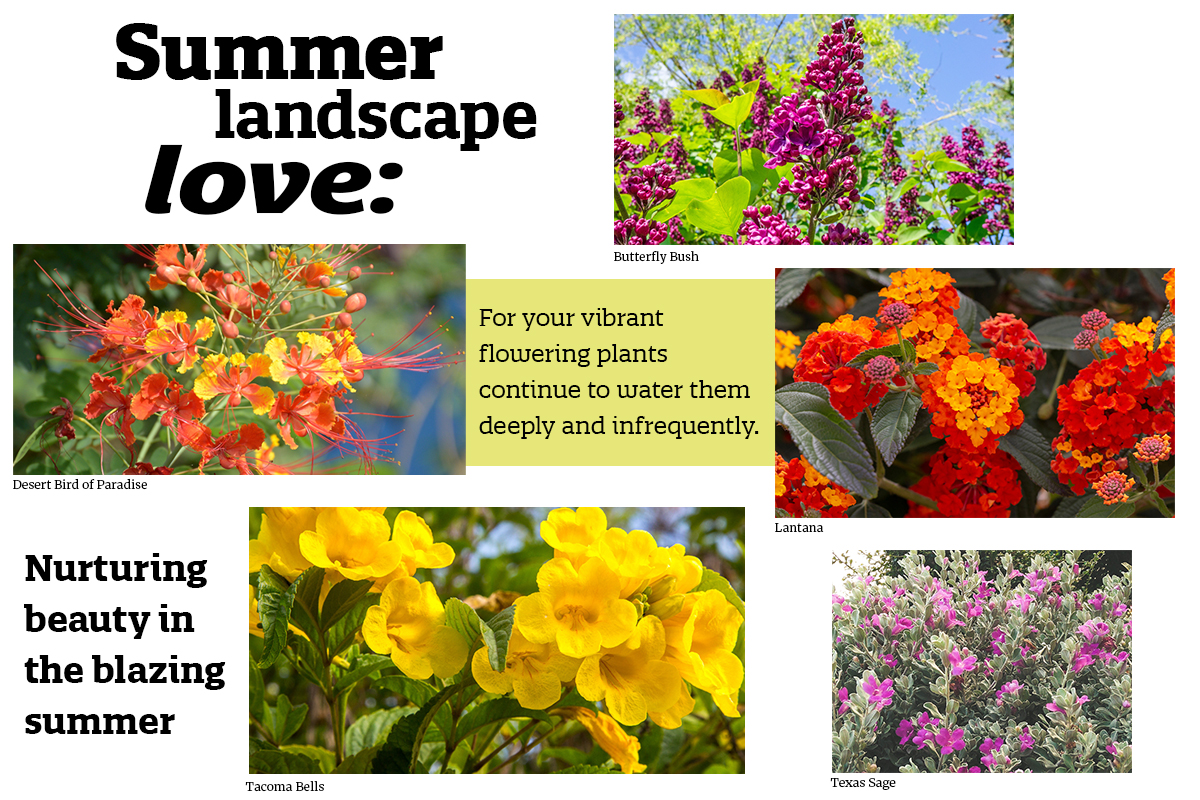
As the Las Vegas Valley bakes under the summer sun, your landscape can flourish with the right care. While heat-loving plants are built for our climate, a little extra attention this month can make all the difference, enhance their performance and prepare them for the intense monsoon season ahead.
Happy Hydration & Blooming Boosts
For your vibrant flowering plants like Lantana, Tacoma Bells, Crape Myrtle, Yellow & Red Desert Bird of Paradise, Butterfly Bush, and Chaste Tree continue to water them deeply and infrequently. This encourages robust root growth. Many of these, including your roses (climbing, bush, and carpet varieties), will benefit greatly from deadheading. This means simply removing all spent flowers. Follow this with a light pruning to shape the plant and then apply a low-nitrogen, high-phosphorous fertilizer like our Dr. Q’s Rose & Flower Food. Always follow the application instructions on the bag for best results. If any plants appear to be distressed by the heat, a light layer of Dr. Q’s Pay Dirt Mix & Mulch around the base can work wonders. This helps improve soil moisture retention and keeps those precious roots cooler.

Palm Perfection & Cactus Care
July is also a good time to tend to your palm trees. Remember, less is often more with palms. Only prune off fronds that are completely brown or falling below the crown of the tree. Over-pruning palms can lead to decline, stress them, and make them more susceptible to insects and disease. Always use clean, sanitized pruning tools. Continue to provide them with deep, long, and infrequent irrigation, and give them a boost with Dr. Q’s Palm Food this month for essential nutrients.
For your cacti, now is the perfect time to fertilize! Give Dr. Q’s Desert Plant Food to support healthy growth through the warm season.
Visit any Star Nursery location to explore our entire line of specialty fertilizers, perfect for all your fertilizing needs!
Managing Desert Tree Growth
Finally, focus on the canopy of desert trees like Acacia, Mesquite, and Palo Verde. Pruning them now can relieve heavy spring growth, making the canopy less dense. This helps prevent branches from breaking under strong dry summer winds and monsoon rains, and controls potential overgrowth during the monsoon rains when thirsty desert plants take advantage of extra water. Be very careful not to over-prune and expose the tender green bark of the Palo Verde, as this can lead to sunburn damage, stressing the trees and inviting issues like beetles and borers. For young tree trunks exposed to the harsh western sun, consider protecting them with either tree paint or tree wrap.
Betsy, the Bloom Seeker asks: “My Green Cloud Texas Sage isn’t blooming, but my neighbor’s is, and they don’t even have a landscaper. What gives?”
Answer: Your question actually holds the answer! The Texas Sage, Leucophyllum frutescens ‘Green Cloud’, is famously known as the “barometer bush.” It has an incredible ability to burst into bloom when atmospheric pressure rises, which is a key indicator of our approaching monsoon rains. If your landscaper is frequently pruning your Texas Sage, especially with a hedge trimmer, they are likely removing all the developing flower buds. For these plants, a natural pruning approach is best. Only prune to shape after their blooming season, allowing the plant to set its buds naturally. As our monsoon season truly arrives, you should see your shrubs come into their full, glorious bloom.
Star Nursery, Your Garden’s Partner for every bloomin’ thing! I’m Joey Lynn and I’ll see you again next month.


